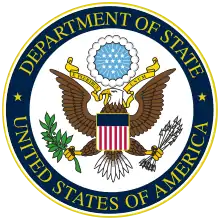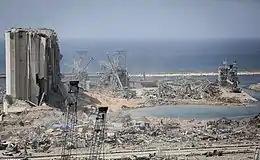Foreign Emergency Support Team
The Foreign Emergency Support Team (FEST) is the U.S. government's only interagency, on-call, short-notice team poised to respond to terrorist incidents worldwide.
 | |
| Agency overview | |
|---|---|
| Formed | 1986 |
| Type | Interagency Task Force |
| Headquarters | Harry S. Truman Building, Washington, D.C. |
| Agency executive | |
| Parent department | U.S. Department of State |
| Parent agency | Bureau of Counterterrorism and Countering Violent Extremism |
History
The FEST was created in 1986, and has long since largely remained shrouded in mystery. Since then has deployed over thirty times to critical situations around the world. The team deploys on four hours notice[1] to assist and advise the U.S. Chief of Mission in assessing crises and coordinating U.S. government crisis response activities.[2]
The Bureau of Counterterrorism (CT) leads the FEST, and it includes representatives from the US Department of State, Department of Defense, the Intelligence Community, and the Federal Bureau of Investigation, and other appropriate agencies, such as the Department of Energy, as circumstances warrant. FEST composition is flexible and tailored to the specific incident and U.S. Embassy needs. The FEST provides specialized crisis response expertise to augment existing U.S. Mission and host government capabilities.[3][4][5] In addition to terrorism, the unit specializes in responding to Weapons of Mass Destruction and CBRNE events.[6]
FEST is the counterpart of the Domestic Emergency Support Team (DEST) which serves a similar role for crises within the United States.
Activity
U.S. Embassy Bombings
The FEST was particularly active when operatives of Osama bin Laden's al-Qaeda network bombed U.S. embassies in Kenya and Tanzania.
USS Cole Bombing
A FEST was deployed to Aden, Yemen following a terrorist attack against the USS Cole, which killed 17 American sailors in October 2000. The FEST advised the US ambassador and helped her direct America's response to the attack. The team relied heavily on FEST's secure mobile communications capability, since the Port of Aden is more than 200 miles from the American Embassy in Sanaa.
Beirut Port Explosion

In August 2020, the FEST C-32B was identified leaving a fuel stop at Stuttgart Airport in Germany en route to Beirut, Lebanon, in the hours after what was later discovered to be an ammonium nitrate fire caused one of the largest artificial non-nuclear explosions in human history in the city's port.[7]
Smaller deployments
The team has been spotted flying into Iraq,[8] throughout central Europe, and several times in Amman, Jordan.[9] Team constituent agencies organize a FEST to conduct training with partner nations often.[2]
Smaller, "tailored" FESTs have responded to abductions of Americans in Ecuador and the Philippines.
Contingency teams
"Contingency" FESTs were deployed to ensure safety at the Olympic Games in Athens, Greece (Summer 2004) and Turin, Italy (Winter 2006), and in Lagos, Nigeria during a hostage-taking crisis.
Assets
Boeing C-32B
_JP6214267.jpg.webp)
The most unique tool the FEST brings to bear are two Boeing C-32B aircraft, serial numbers 02-4452 and 02-5001 operated by the United States Air Force Special Operations Command (AFSOC).[10] The C-32B has been associated with the 150th Special Operations Squadron out of McGuire Air Force Base, New Jersey (previously designated as 227th Special Operations Flight) and the 486th Flight Test Squadron out of Eglin Air Force Base, Florida.[10]
The aircraft serve as on-call global transport, and are one-off variants of the Boeing 757, similar to the C-32A which serves as executive aircraft for senior leaders including the Vice President and Secretary of State. The two aircraft differ significantly from their VIP-carrying counterparts however, and they are outfitted with an advanced communications suite and are designed for ultra long-range capability. All cargo must be stored in the rear of the aircraft as enlarged fuel tanks replace the entire below-deck cargo hold, extending the aircraft's unrefueled maximum range to 6000 nautical miles.[11] They also have an aerial refueling capability via an unmarked conformal Universal Aerial Refueling Receptacle Slipway Installation (USRRSI) located atop the fuselage, 15 feet aft of the nose, along the aircraft's centerline, allowing the planes to remain airborne nearly indefinitely.[12][13][14]
The planes are generally painted white and lack any external markings other than serial numbers, although they have been spotted with "United States Air Force" emblazoned on the cheatline and the Air Force roundel on the tail section of the fuselage at times,[15] or solely a small American flag on the same area of the rear fuselage at others.[14] The aircraft have been known to change serial number frequently to confuse the number of airframes in service and their whereabouts, and they are operated by the secretive and deceptively named Air Force 486th Flight Test Squadron at Eglin AFB, a unit heavily associated with U.S. special operations and the intelligence community.[11] The development of the two aircraft emerged out of the 2001 Air Force budget, where details are largely classified other than to identify their association with FEST and reveal that the procurement cost was estimated at $144.963 million.[16]
References
- "Ten Things You Should Know About the State Department's Bureau of Counterterrorism". United States Department of State. Retrieved 2020-11-15.
- "Programs and Initiatives". 2009-2017.state.gov. Retrieved 2020-10-25.
- "Programs and Initiatives". www.state.gov.
- "Foreign Emergency Support Team (FEST)". US Department of State. Retrieved on May 8, 2013
- State Department OIG (May 2020). "State Department Office of Inspector General Inspection of the Bureau of Counterterrorism" (PDF). U.S. Department of State.
- "Tactical Programs, PHE". www.phe.gov. March 17, 2017. Retrieved 2020-10-26.
- "00-9001 | Boeing C-32B | United States - US Air Force (USAF) | Simon Reichert". JetPhotos. Retrieved 2020-10-26.
- Gomez, Manu. "FEST C32B Flight Radar". Twitter. Retrieved 2020-10-26.
- Pio, Jordan (October 8, 2020). "C32B in Jordan". Twitter. Retrieved 2020-10-26.
- "Boeing C-32B - USAF Special Operations". www.americanspecialops.com. Retrieved 2021-01-18.
- "Boeing C-32B - USAF Special Operations". www.americanspecialops.com. Retrieved 2020-10-25.
- "Foreign Emergency Support Team (FEST) Boeing C-32B (757-23A) at Joint Base McGuire-Dix-Lakehurst, NJ". Virtual Globetrotting. February 27, 2008. Retrieved 2020-10-25.
- Rogoway, Tyler (October 9, 2020). "Secretive Tonopah Test Range Airport Had A Mysteriously Busy Week In September". The Drive. Retrieved 2020-10-25.
- Fisherbray (February 10, 2015). "Boeing C32B".
- Ferro, Daniel (January 1, 2020). "C32B Rota Spain". Twitter. Retrieved 2020-10-26.
- Air Force, U.S. (February 1, 2000). "USAF Committee Staff Procurement Backup Book FY 2001 Amended Budget Request" (PDF). Global Security.